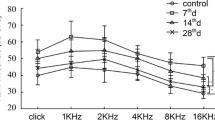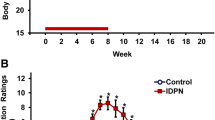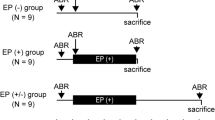Abstract
Faithful information transfer at the hair cell afferent synapse requires synaptic transmission to be both reliable and temporally precise. The release of neurotransmitter must exhibit both rapid on and off kinetics to accurately follow acoustic stimuli with a periodicity of 1 ms or less. To ensure such remarkable temporal fidelity, the cochlear hair cell afferent synapse undoubtedly relies on unique cellular and molecular specializations. To study effects of different doses of gentamicin on the changes of synaptic ribbons of cochlear inner hair cells (IHCs) in mice, the availability of genetic information, transgenic and knock-out animals make the C57BL/6J mouse a primary model in biomedical research. Aminoglycoside ototoxicity, however, has rarely been studied in mature mice because they are considered highly resistant to the drugs. This study presents models for gentamicin ototoxicity in adult C57BL/6J mouse strains. Five-week-old mice were injected intraperitoneally once daily with 50–300 mg gentamicin base/kg body weight for 7 days. Higher doses of gentamicin appear to be associated with earlier hearing damage in C57BL/6J mice, although not necessarily with more severe damage. At 200 mg/kg, gentamicin appears to induce significant hearing damage while not significantly affect the animal’s general condition. Therefore, 200 mg/kg may be an ideal dose for ototoxicity modeling in C57BL/6J mice using gentamicin. In the early period of different dose of gentamicin effect, when the number of hair cells had not changed, the number changes of IHC ribbon synapses had taken place. Through the number of ribbon synapses changing, IHCs increased or decreased connections with spiral ganglion nerves (SGNs). The ribbon synapses played a compensatory role for gentamicin ototoxicity, while this effect was not sufficient to maintain the normal threshold of hearing.

Similar content being viewed by others
References
Wu WJ, Sha SH, McLaren JD, Kawamoto K, Raphael Y, Schacht J (2001) Aminoglycoside ototoxicity in adult CBA, C57BL and BALB mice and the Sprague Dawley rat. Hear Res 158:165–178
Nakagawa T, Yamane H, Shibata S, Nakai Y (1997) Gentamicin ototoxicity induced apoptosis of the vestibular hair cells of guinea pigs. Eur Arch Otorhinolaryngol 254:9–14
Murillo-Cuesta S, Contreras J, Cediel R, Varela-Nieto I (2010) Comparison of different aminoglycoside antibiotic treatments to refine ototoxicity studies in adult mice. Lab Anim 44:124–131
Rizzi MD, Hirose K (2007) Aminoglycoside ototoxicity. Curr Opin Otolaryngol Head Neck Surg 15:352–357
Lin CT, Young YH, Cheng PW, Lue JH (2010) Effects of gentamicin on guinea pig vestibular ganglion function and on substance P and neuropeptide Y. J Chem Neuroanat 40:286–292
Dehne N, Rauen U, de Groot H, Lautermann J (2002) Involvement of the mitochondrial permeability transition in gentamicin ototoxicity. Hear Res 169:47–55
Gooi A, Hochman J, Wellman M, Blakeley L, Blakley BW (2008) Ototoxic effects of single-dose versus 19-day daily-dose gentamicin. J Otolaryngol Head Neck Surg 37:664–667
Lee JE, Nakagawa T, Kim TS, Iquchi F, Endo T, Kita T, Murai N, Natio Y, Lee SH, Ito J (2004) Signaling pathway for apoptosis of veshair cells of mice due to aminoglycosides. Acta Otolaryngol Suppl 551:69–74
Castillo E, Carricondo F, Bartolomé MV, Vicente-Torres A, Poch Broto J, Gil-Loyzaqa P (2006) Presbycusis: neural degeneration and aging on the auditory receptor of C57/BL6J mice. Acta Otorrinolaringol Esp 57:383–387
Brown SD, Hardisty-Hughes RE, Mburu P (2008) Quiet as a mouse: dissecting the molecular and genetic basis of hearing. Nat Rev Genet 9:277–290
Pfannenstiel SL, Praetorius M, Plinkert PK, Brouqh DE, Staecker H (2009) Bcl-2 gene therapy prevents aminoglycoside-induced degeneration of auditory and vestibular hair cells. Audiol Neurootol 14:254–266
Idrizbegovic E, Bogdanovic N, Willott JF, Canlon B (2004) Age-related increases in calcium-binding protein immunoreactivity in the cochlear nucleus of hearing impaired C57BL/6J mice. Neurobiol Aging 25:1085–1093
McFadden SL, Ding D, Salvi R (2001) Anatomical, metabolic and genetic aspects of age-related hearing loss in mice. Audiology 40:313–321
Frisina RD, Newman SR, Zhu X (2007) Auditory efferent activation in CBA mice exceeds that of C57s for varying levels of noise. J Acoust Soc Am 121:29–34
Maudonnet EN, de Oliveira JA, Rossato M, Hyppolito MA (2008) Gentamicin attenuates gentamicin-induced ototoxicity-self-protection. Drug Chem Toxicol 31:11–25
Vakulenko SB, Mobashery S (2003) Versatility of aminoglycosides and prospects for their future. Clin Microbiol Rev 16:430–450
Forge A, Schacht J (2000) Aminoglycoside antibiotics. Audiol Neurootol 5:3–22
Takeuchi S, Ando M, Kakigi A (2000) Mechanism generating endocochlear potential: role played by intermediate cells in stria vascularis. Biophys J 79:2572–2582
Wagner HJ (1997) Presynaptic bodies (“ribbons”): from ultrastructural observations to molecular perspectives. Cell Tiss Res 287:435–446
Vollrath L, Spiwoks-Becker I (1996) Plasticity of retinal ribbon synapses. Microsc Res Tech 35:472–487
Spiwoks-Becker I, Glas M, Lasarzik I, Vollrath L (2004) Mouse photoreceptor synaptic ribbons lose and regain material in response to illumination. Eur J Neurosci 19:1559–1571
Johnson SL, Forge A, Knipper M, Münkner S, Marcotti W (2008) Tonotopic variation in the calcium dependence of neurotransmitter release and vesicle pool replenishment at mammalian auditory ribbon synapses. J Neurosci 28:7670–7678
Roux I, Safieddine S, Nouvian R, Grati M, Simmler MC, Bahloul A, Perfettini I, Le Gall M, Rostaing P, Hamard G, Triller A, Avan P, Moser T, Petit C (2006) Otoferlin, defective in a human deafness form, is essential for exocytosis at the auditory ribbon synapse. Cell 127:277–289
Meyer AC, Frank T, Khimich D, Hoch G, Riedel D, Chapochnikov NM, Yarin YM, Harke B, Hell SW, Eqner A, Moser T (2009) Tuning of synapse number, structure and function in the cochlea. Nat Neurosci 12:444–453
Bertolaso L, Bindini D, Previati M, Falgione D, Lanzoni I, Parmeggiani A, Vitali C, Corbacella E, Capitani S, Martini A (2003) Gentamicin-induced cytotoxicity involves protein kinase C activation, glutathione extrusion and malondialdehyde production in an immortalized cell line from the organ of corti. Audiol Neurootol 8:38–48
Regus-Leidig H, Tom Dieck S, Specht D, Meyer L, Brandstätter JH (2009) Early steps in the assembly of photoreceptor ribbon synapses in the mouse retina: the involvement of precursor spheres. J Comp Neurol 512:814–824
Magupalli V, Schwarz K, Alpadi K, Natarajan S, Seigel GM, Schmitz F (2008) Multiple RIBEYE-RIBEYE interactions create a dynamic scaffold for the formation of synaptic ribbons. J Neurosci 28:7954–7967
Tom Dieck S, Altrock WD, Kessels MM, Qualmann B, Regus H, Brauner D, Fejtová A, Bracko O, Gundelfinger ED, Brandstätter JH (2005) Molecular dissection of the photoreceptor ribbon synapse: physical interaction of Bassoon and RIBEYE is essential for the assembly of the ribbon complex. J Cell Biol 168:825–836
Schoch S, Gundelfinger ED (2006) Molecular organization of the presynaptic active zone. Cell Tis Res 326:379–391
Filippi S, Motyl B, Bandera C (2008) Analysis of existing methods for 3D modelling of femurs starting from two orthogonal images and development of a script for a commercial software package. Comput Methods Programs Biomed 89:76–82
Ma B, Wang L, von Wasielewski R, Lindenmaier W, Dittmar KE (2008) Serial sectioning and three-dimensional reconstruction of mouse Peyer’s Patch. Micron 39:967–975
Acknowledgments
This work was supported by Education Fund L2010564, Technology Fund 2011225020 and Doctoral Scientific Research Fund 20101142 of Liaoning Province of China; National Natural Science Found 81100243.
Author information
Authors and Affiliations
Corresponding author
Rights and permissions
About this article
Cite this article
Chen, L., Xiong, S., Liu, Y. et al. Effect of Different Gentamicin Dose on the Plasticity of the Ribbon Synapses in Cochlear Inner Hair Cells of C57BL/6J Mice. Mol Neurobiol 46, 487–494 (2012). https://doi.org/10.1007/s12035-012-8312-7
Received:
Accepted:
Published:
Issue Date:
DOI: https://doi.org/10.1007/s12035-012-8312-7




